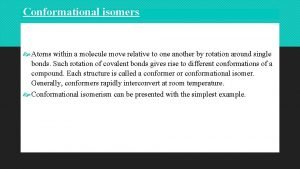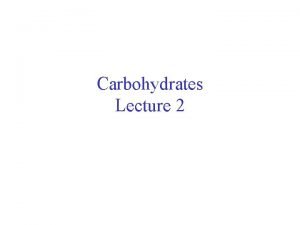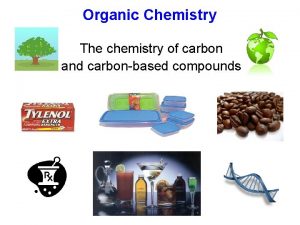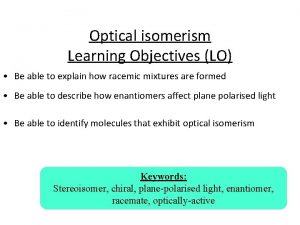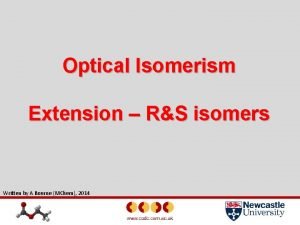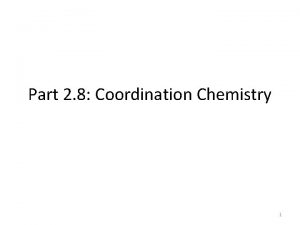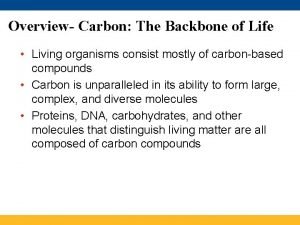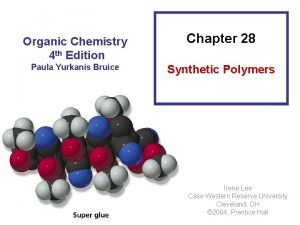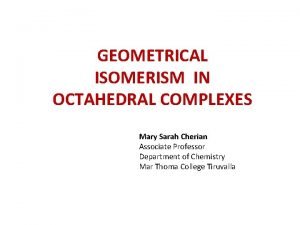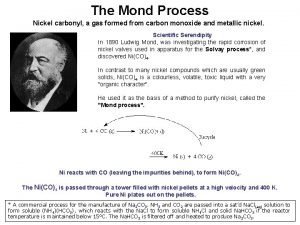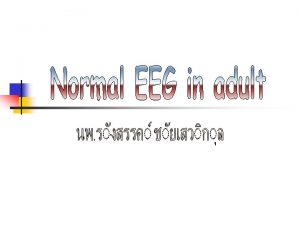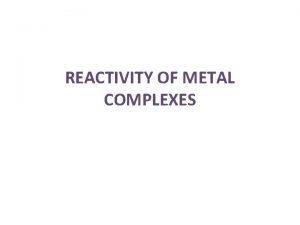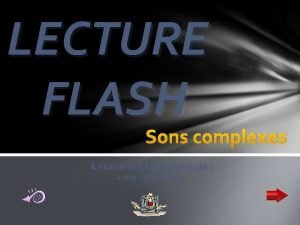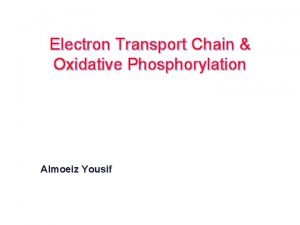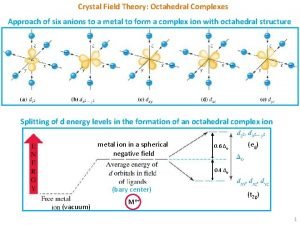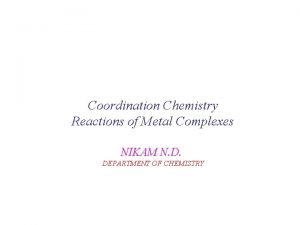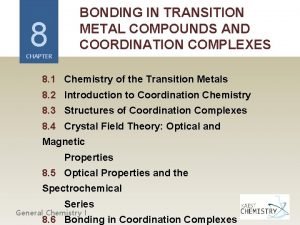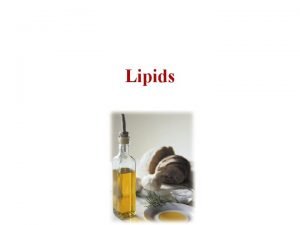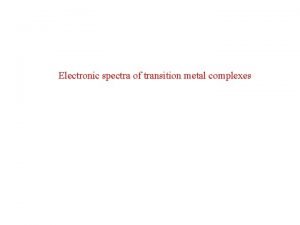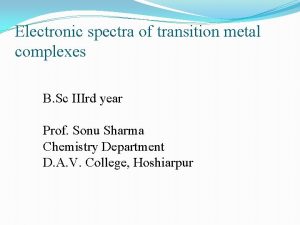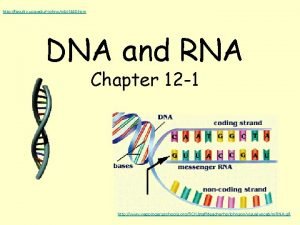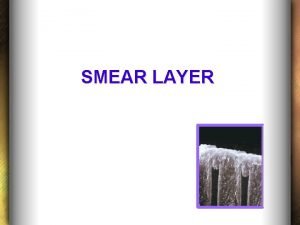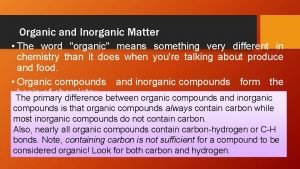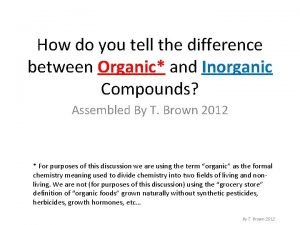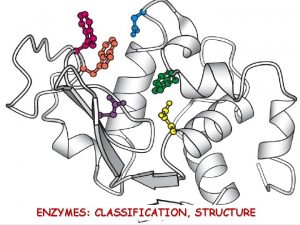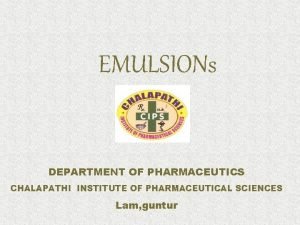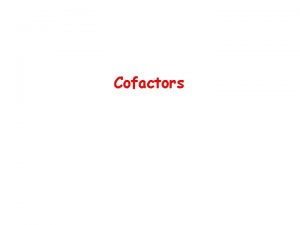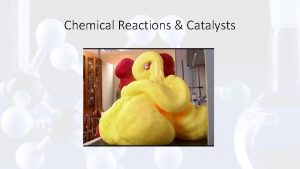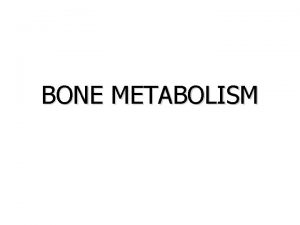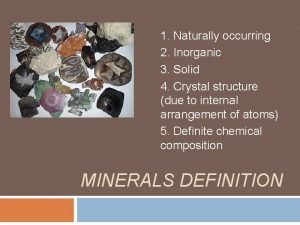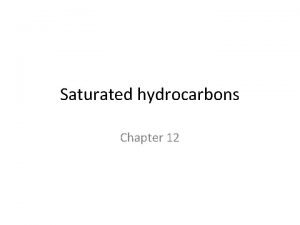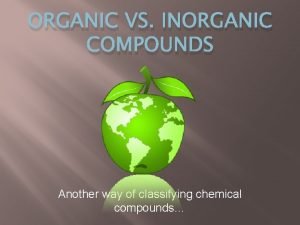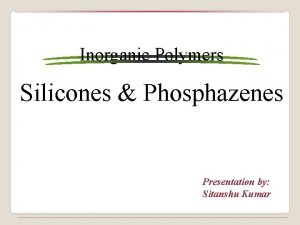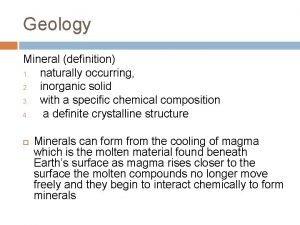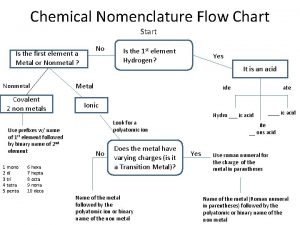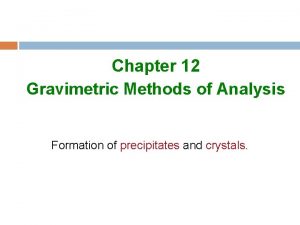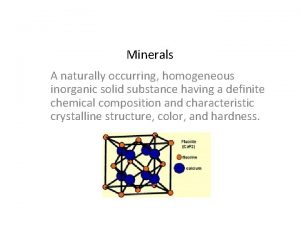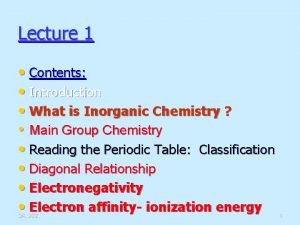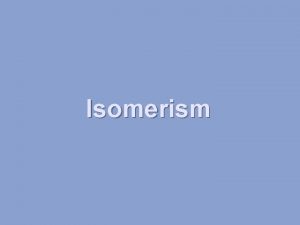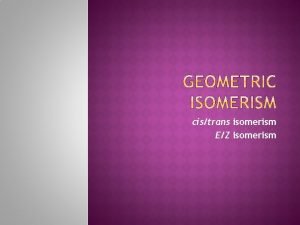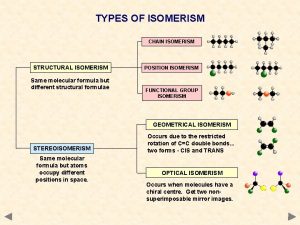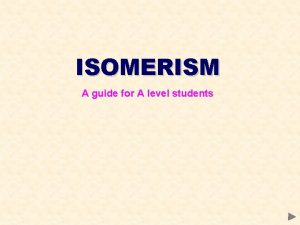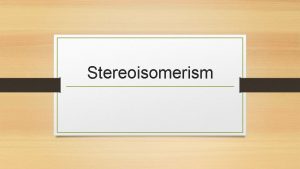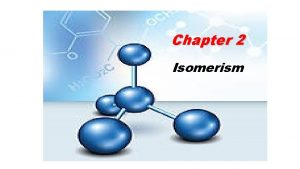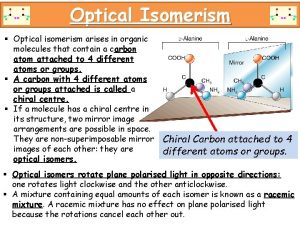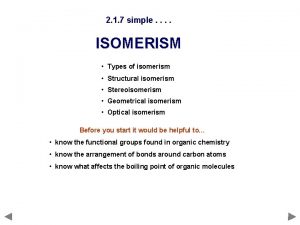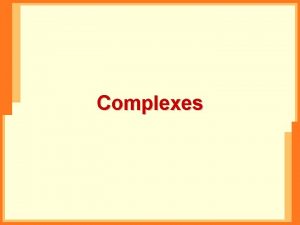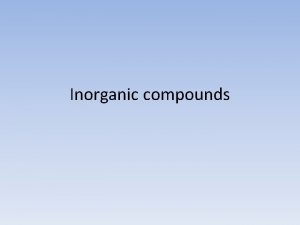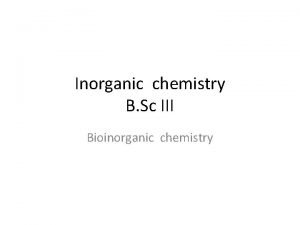UNIT VA ISOMERISM AMONGS INORGANIC COMPLEXES Two or






![e. g. [Co(pn)2 Cl 2]+ and [Co(tn)2 Cl 2]+ ions e. g. [Co(pn)2 Cl 2]+ and [Co(tn)2 Cl 2]+ ions](https://slidetodoc.com/presentation_image_h/d8412bc28f0c7b6a8c2ea3744ce60d97/image-7.jpg)





![Square planar complexes A planar species [Ma 2 b 2] can exist in 1, Square planar complexes A planar species [Ma 2 b 2] can exist in 1,](https://slidetodoc.com/presentation_image_h/d8412bc28f0c7b6a8c2ea3744ce60d97/image-13.jpg)

![[Ma 2 b 2]±n type: Here M is central ion and ‘a’ and ‘b’ [Ma 2 b 2]±n type: Here M is central ion and ‘a’ and ‘b’](https://slidetodoc.com/presentation_image_h/d8412bc28f0c7b6a8c2ea3744ce60d97/image-15.jpg)
![[Ma 2 bc] ±n type: In this type ‘a’ is any neutral ligand such [Ma 2 bc] ±n type: In this type ‘a’ is any neutral ligand such](https://slidetodoc.com/presentation_image_h/d8412bc28f0c7b6a8c2ea3744ce60d97/image-16.jpg)
![M[abcd] ±n type Complexes of this type exist in three isomeric forms as shown M[abcd] ±n type Complexes of this type exist in three isomeric forms as shown](https://slidetodoc.com/presentation_image_h/d8412bc28f0c7b6a8c2ea3744ce60d97/image-17.jpg)
![Square planar complexes containing unsymmetrical bidentate chelating ligands: [M(AB)2]±n AB is unsymmetrical bidentate chelating Square planar complexes containing unsymmetrical bidentate chelating ligands: [M(AB)2]±n AB is unsymmetrical bidentate chelating](https://slidetodoc.com/presentation_image_h/d8412bc28f0c7b6a8c2ea3744ce60d97/image-18.jpg)
![Square planar complexes containing symmetrical bidentate chelating ligands: [M(AA)2]±n where AA is symmetrical bidentate Square planar complexes containing symmetrical bidentate chelating ligands: [M(AA)2]±n where AA is symmetrical bidentate](https://slidetodoc.com/presentation_image_h/d8412bc28f0c7b6a8c2ea3744ce60d97/image-19.jpg)



![Octahedral Complexes containing monodentate ligands 1. [Ma 4 b 2]±n type 2. [Ma 3 Octahedral Complexes containing monodentate ligands 1. [Ma 4 b 2]±n type 2. [Ma 3](https://slidetodoc.com/presentation_image_h/d8412bc28f0c7b6a8c2ea3744ce60d97/image-23.jpg)
![Octahedral Complexes containing monodentate ligands In this complexes, [Ma 6]±n, [Ma 5 b]±n and Octahedral Complexes containing monodentate ligands In this complexes, [Ma 6]±n, [Ma 5 b]±n and](https://slidetodoc.com/presentation_image_h/d8412bc28f0c7b6a8c2ea3744ce60d97/image-24.jpg)
![[Ma 4 b 2]±n type Two ‘b’ ligands have adjacent position for cis isomers, [Ma 4 b 2]±n type Two ‘b’ ligands have adjacent position for cis isomers,](https://slidetodoc.com/presentation_image_h/d8412bc28f0c7b6a8c2ea3744ce60d97/image-25.jpg)
![Example: [Co(NH 3)4 Cl 2]+ In cis isomers, two Cl – ions are at Example: [Co(NH 3)4 Cl 2]+ In cis isomers, two Cl – ions are at](https://slidetodoc.com/presentation_image_h/d8412bc28f0c7b6a8c2ea3744ce60d97/image-26.jpg)
![[Ma 3 b 3]±n type In cis isomers, three ‘a’ occupy 1, 2 and [Ma 3 b 3]±n type In cis isomers, three ‘a’ occupy 1, 2 and](https://slidetodoc.com/presentation_image_h/d8412bc28f0c7b6a8c2ea3744ce60d97/image-27.jpg)
![Example: [Cr(NH 3)3 Cl 3], [Rh(py)3 Cl 3] • In cis isomer, three Cl- Example: [Cr(NH 3)3 Cl 3], [Rh(py)3 Cl 3] • In cis isomer, three Cl-](https://slidetodoc.com/presentation_image_h/d8412bc28f0c7b6a8c2ea3744ce60d97/image-28.jpg)
![[Mabcdef]±n type In this type of complexes there are 15 different geometrical isomers in [Mabcdef]±n type In this type of complexes there are 15 different geometrical isomers in](https://slidetodoc.com/presentation_image_h/d8412bc28f0c7b6a8c2ea3744ce60d97/image-29.jpg)
![Octahedral Complexes containing monodentate and symmetrical bidentate ligands [M(AA)2 a 2]±n type In cis Octahedral Complexes containing monodentate and symmetrical bidentate ligands [M(AA)2 a 2]±n type In cis](https://slidetodoc.com/presentation_image_h/d8412bc28f0c7b6a8c2ea3744ce60d97/image-30.jpg)
![Example: [Co(en)2(NO 2)2]+, [Ir(C 2 O 4)2 Cl 2]2 -, [Rr(C 2 O 4)2 Example: [Co(en)2(NO 2)2]+, [Ir(C 2 O 4)2 Cl 2]2 -, [Rr(C 2 O 4)2](https://slidetodoc.com/presentation_image_h/d8412bc28f0c7b6a8c2ea3744ce60d97/image-31.jpg)
![[M(AA)2 ab]±n type Example: [Co(en)2(NH 3)Cl]2+, [Ru(py)(C 2 O 4)2 (NO)] etc. [M(AA)2 ab]±n type Example: [Co(en)2(NH 3)Cl]2+, [Ru(py)(C 2 O 4)2 (NO)] etc.](https://slidetodoc.com/presentation_image_h/d8412bc28f0c7b6a8c2ea3744ce60d97/image-32.jpg)
![[M(AA)a 2 b 2]±n type Example: [Co(en)(NH 3)2 Cl 2]2+ [M(AA)a 2 b 2]±n type Example: [Co(en)(NH 3)2 Cl 2]2+](https://slidetodoc.com/presentation_image_h/d8412bc28f0c7b6a8c2ea3744ce60d97/image-33.jpg)
![Octahedral Complexes containing unsymmetrical bidentate chelating ligands: [M(AB)3]±n type Example: [Cr(gly)3] Octahedral Complexes containing unsymmetrical bidentate chelating ligands: [M(AB)3]±n type Example: [Cr(gly)3]](https://slidetodoc.com/presentation_image_h/d8412bc28f0c7b6a8c2ea3744ce60d97/image-34.jpg)



![IR technique The trans complexes such as [Co(NH 3)4 Cl 2]+ or [Co(NH 3)2 IR technique The trans complexes such as [Co(NH 3)4 Cl 2]+ or [Co(NH 3)2](https://slidetodoc.com/presentation_image_h/d8412bc28f0c7b6a8c2ea3744ce60d97/image-38.jpg)





![e. g. [Pt(NH 3)2 Cl 2] In cis isomer both Cl- ion are trans e. g. [Pt(NH 3)2 Cl 2] In cis isomer both Cl- ion are trans](https://slidetodoc.com/presentation_image_h/d8412bc28f0c7b6a8c2ea3744ce60d97/image-44.jpg)









![Example: [As(CH 3)(C 2 H 5)S(C 6 H 4 COO)]+2 Example: [As(CH 3)(C 2 H 5)S(C 6 H 4 COO)]+2](https://slidetodoc.com/presentation_image_h/d8412bc28f0c7b6a8c2ea3744ce60d97/image-54.jpg)


![[Ma 2 b 2 c 2]±n type Example: [Co(NH 3)2 Cl 2(NO 2)2]-1 [Ma 2 b 2 c 2]±n type Example: [Co(NH 3)2 Cl 2(NO 2)2]-1](https://slidetodoc.com/presentation_image_h/d8412bc28f0c7b6a8c2ea3744ce60d97/image-57.jpg)
![[Mabcdef] ]±n type Only Pt(IV) complexes are existing. There are 15 geometrical isomers, each [Mabcdef] ]±n type Only Pt(IV) complexes are existing. There are 15 geometrical isomers, each](https://slidetodoc.com/presentation_image_h/d8412bc28f0c7b6a8c2ea3744ce60d97/image-58.jpg)
![Octahedral complexes containing only symmetrical bidentate chelating ligands [M(AA)3]±n type Example: [Co(en)3]+3, [Co(pn)3]+3, [Pt(en)3]+3, Octahedral complexes containing only symmetrical bidentate chelating ligands [M(AA)3]±n type Example: [Co(en)3]+3, [Co(pn)3]+3, [Pt(en)3]+3,](https://slidetodoc.com/presentation_image_h/d8412bc28f0c7b6a8c2ea3744ce60d97/image-59.jpg)
![Octahedral complexes containing monodentate and symmetrical bidentate chelating ligands [M(AA)2 a 2]±n type [Co(en)2 Octahedral complexes containing monodentate and symmetrical bidentate chelating ligands [M(AA)2 a 2]±n type [Co(en)2](https://slidetodoc.com/presentation_image_h/d8412bc28f0c7b6a8c2ea3744ce60d97/image-60.jpg)
![[M(AA)2 ab]±n type These complexes also exist in three form in which two form [M(AA)2 ab]±n type These complexes also exist in three form in which two form](https://slidetodoc.com/presentation_image_h/d8412bc28f0c7b6a8c2ea3744ce60d97/image-61.jpg)
![[M(AA)a 2 b 2]±n type These complexes also exist in three form in which [M(AA)a 2 b 2]±n type These complexes also exist in three form in which](https://slidetodoc.com/presentation_image_h/d8412bc28f0c7b6a8c2ea3744ce60d97/image-62.jpg)
![Octahedral complexes containing optically active ligand Example: [Co(en)(pn)(NO 2)2]+ Octahedral complexes containing optically active ligand Example: [Co(en)(pn)(NO 2)2]+](https://slidetodoc.com/presentation_image_h/d8412bc28f0c7b6a8c2ea3744ce60d97/image-63.jpg)


![Example: In resolution of recemic mixture containing d-cis [Co(en)3]Cl 3 and l-cis [Co(en)3]Cl 3 Example: In resolution of recemic mixture containing d-cis [Co(en)3]Cl 3 and l-cis [Co(en)3]Cl 3](https://slidetodoc.com/presentation_image_h/d8412bc28f0c7b6a8c2ea3744ce60d97/image-66.jpg)

- Slides: 67

UNIT VA ISOMERISM AMONGS INORGANIC COMPLEXES Two or more different compounds having the same molecular formula are called isomers and the phenomenon is called isomerism. Isomerism arises due to specific spatial dispositions of the atoms in a molecule. Due to covalence of M-L bonds, many types of isomers occur in co-ordination compounds. However, compared to organic compounds, relatively few inorganic compounds exhibit isomerism.

Importance of isomerism in coordination chemistry Apart from complicating the study of co-ordination compounds due to a large variety of isomerism possible in complexes, the study of isomers played a very vital role in establishing the stereochemistry of complexes. Long before the advantage of physical methods of structure determination, like X-ray diffraction, such studies had established the stereochemistry of 6 - and 4 - co-ordinate complexes.

TYPES OF ISOMERISM Structural isomerism 1. Ionization isomerism 2. Hydrate isomerism 3. Ligand isomerism 4. Linkage (salt) isomerism 5. Co-ordination position isomerism 6. Co-ordination isomerism Stereoisomerism 1. Geometrical isomerism (cis-trans isomerism) 2. Optical isomerism (mirror image isomerism)

Ionization isomerism Ionisation isomers are the compounds that have the same molecular formula but give different ions in the solution. This occurs due to interchange of the ligand anion of the central metal atom and the external anion associated with the complex. e. g. [Co(NH 3)5 Br]+2 SO 4 -2 & [Co(NH 3)5 SO 4]+1 Br-1 • [Co(NH 3)5 Br]+2 SO 4 -2 gives white ppts of Ba. SO 4 with aq Ba. Cl 2 while Co(NH 3)5 SO 4]+1 Br -1 does not. • Similarly Co(NH 3)5 SO 4]+1 Br -1 gives yellow ppts of Ag. Br with aq. silver nitrate, while [Co(NH 3)5 Br]+2 SO 4 -2 does not. • Other examples are [Pt(NH 3)4 Cl 2]Br 2 and [Pt(NH 3)4 Br 2]Cl 2, [Co(en)2 NO 2 Cl]SCN & [Co(en)2 NO 2 SCN]Cl

Hydrate isomerism: This isomerism arises due to different positions of water molecules in the complex (interchange between complex and rest of the compound). e. g. Cr. Cl 3 6 H 2 O that is found in 3 -isomeric forms. • [Cr(H 2 O)6]Cl 3: Violet, 4 ions, Equi. cond ~425, All chlorine ppted as Ag. Cl, No loss of water in a desicator over conc. sulfuric acid. • [Cr(H 2 O)5 Cl]Cl 2 H 2 O: Blue green, 3 ions, ~250, 2/3 chlorine ppted, One lost over conc sulfuric acid. • [Cr(H 2 O)4 Cl 2]Cl 2 H 2 O: Darkgreen, 2 ions, ~130, 1/3 chlorine ppted, Two H 2 O lost over conc sulfuric acid.

Ligand isomerism Some of the ligands themselves are capable of existing as isomers, e. g. diaminopropane can exist isomers as 1, 2 -diaminopropane (pn) and 1, 3 -diaminopropane (tn).
![e g Copn2 Cl 2 and Cotn2 Cl 2 ions e. g. [Co(pn)2 Cl 2]+ and [Co(tn)2 Cl 2]+ ions](https://slidetodoc.com/presentation_image_h/d8412bc28f0c7b6a8c2ea3744ce60d97/image-7.jpg)
e. g. [Co(pn)2 Cl 2]+ and [Co(tn)2 Cl 2]+ ions

Linkage isomerism This arises when the ligand can co-ordinate either of two different donor atoms (ambidentate ligands), e. g. NO 2 - ion may attach with the central ion either through O atm or through N atom. i. e. [Co(NH 3)5 -ONO]+2 & [Co(NH 3)5 -NO 2]+2. Other ligands are SCN-, S 2 O 3 -2 etc.

Coordination isomerism This can occur only with salts in which both cation and anion parts are complexes and the ligands have a different distribution between the two central metal atoms (i. e. exchange of ligands between two coordination spheres). e. g. [Cr(NH 3)6]+3[Cr(SCN)6]-3 & [Cr(NH 3)4(SCN)2]+[Cr(NH 3)2(SCN)4]- (same central atom) [Co(NH 3)6]+3[Cr(CN)6]-3 & [Cr(NH 3)6]+3[Co(CN)6]-3 (different central atom)

Coordination position isomerism In some of the polynuclear complexes, interchange of the ligands between the two metal nuclei takes place, which is give to rice to coordination position isomerism. e. g.

STEREOISOMERISM or SPACE ISOMERISM When two compounds have same ligands but its arrangement in space is different is known as space isomerism. There are two forms of stereoisomerism. 1. Geometrical Isomerism (cis-trans) 2. Optical Isomerism (mirror image)

GEOMETRICAL ISOMERISM or CIS-TRANS ISOMERISM 4 -Coordinate complexes The arrangement of four ligands around the central metal atom may be tetrahedral or square planar. Tetrahedral complexes A regular tetrahedral species [Ma 4], [Ma 2 b 2] or [Mabcd] can exist in only one geometrical form (no geometrical isomers) since arrangement of every ligand atom or group around the central atom in space is equivalent.
![Square planar complexes A planar species Ma 2 b 2 can exist in 1 Square planar complexes A planar species [Ma 2 b 2] can exist in 1,](https://slidetodoc.com/presentation_image_h/d8412bc28f0c7b6a8c2ea3744ce60d97/image-13.jpg)
Square planar complexes A planar species [Ma 2 b 2] can exist in 1, 2 or cis and 1, 3 or trans form. No stereoisomer are possible for planar species of the type [Ma 4], [Ma 3 b] or [Mab 3] because all possible arrangements of a and b for each of these types are exactly equivalent.

Following types of complexes are show geometrical isomers 1. Complexes containing only monodentate ligand • [Ma 2 b 2]±n • [Ma 2 bc] ±n • [Mabcd] ±n 2. Square planar complexes containing unsymmetrical bidentate chelating ligands [M(AB)2]±n 3. Square planar complexes containing symmetrical bidentate chelating ligands [M(AA)2]±n 4. Bridged binuclear planar complexes M 2 a 2 b 4
![Ma 2 b 2n type Here M is central ion and a and b [Ma 2 b 2]±n type: Here M is central ion and ‘a’ and ‘b’](https://slidetodoc.com/presentation_image_h/d8412bc28f0c7b6a8c2ea3744ce60d97/image-15.jpg)
[Ma 2 b 2]±n type: Here M is central ion and ‘a’ and ‘b’ are monodentate ligands. Complexes of this type exist following cis-trans isomers. e. g. [Pt(NH 3)2 Cl 2] [Pd(NH 3)2(NO 3)2] also show cis-trans isomer.
![Ma 2 bc n type In this type a is any neutral ligand such [Ma 2 bc] ±n type: In this type ‘a’ is any neutral ligand such](https://slidetodoc.com/presentation_image_h/d8412bc28f0c7b6a8c2ea3744ce60d97/image-16.jpg)
[Ma 2 bc] ±n type: In this type ‘a’ is any neutral ligand such as NH 3, py, H 2 O and ‘b’ and ‘c’ are anionic ligands like Cl-, Br-, NO 2 - etc. e. g. [Pt(NH 3)2 Cl. NO 2]
![Mabcd n type Complexes of this type exist in three isomeric forms as shown M[abcd] ±n type Complexes of this type exist in three isomeric forms as shown](https://slidetodoc.com/presentation_image_h/d8412bc28f0c7b6a8c2ea3744ce60d97/image-17.jpg)
M[abcd] ±n type Complexes of this type exist in three isomeric forms as shown below examples are [Pt(NH 3)Cl. Br. NO 2], [Pt(NH 3)2 py. Cl. Br], [Pt(NO 2)py(NH 3)(NH 2 OH)]+, [Pt(C 2 H 4)(NH 3)Cl. Br]
![Square planar complexes containing unsymmetrical bidentate chelating ligands MAB2n AB is unsymmetrical bidentate chelating Square planar complexes containing unsymmetrical bidentate chelating ligands: [M(AB)2]±n AB is unsymmetrical bidentate chelating](https://slidetodoc.com/presentation_image_h/d8412bc28f0c7b6a8c2ea3744ce60d97/image-18.jpg)
Square planar complexes containing unsymmetrical bidentate chelating ligands: [M(AB)2]±n AB is unsymmetrical bidentate chelating ligands containing A and B are two end of the ligand. e. g. [Pt(gly)2] where gly is NH 2 -CH 2 COO- (glycine ion), exist following cis-trans isomers
![Square planar complexes containing symmetrical bidentate chelating ligands MAA2n where AA is symmetrical bidentate Square planar complexes containing symmetrical bidentate chelating ligands: [M(AA)2]±n where AA is symmetrical bidentate](https://slidetodoc.com/presentation_image_h/d8412bc28f0c7b6a8c2ea3744ce60d97/image-19.jpg)
Square planar complexes containing symmetrical bidentate chelating ligands: [M(AA)2]±n where AA is symmetrical bidentate chelating ligands. e. g. [Pt(NH 2 CH(CH 3)NH 2)2]+2

Bridged binuclear planar complexes of M 2 a 2 b 4 type In this type of complexes cis and trans isomers as well as the unsymmetrical form also exist as shown below. e. g. [Pt(PEt 3)Cl 2]2

6 -Coordinate complexes Three possible arrangements of six ligands around the central metal atom, namely • Planar hexagonal • Trigonal prismatic • Octahedral The physical and chemical evidences, especially those based on isomerism have shown that the arrangement of six ligands in a 6 -coordinate complex is always octahedral with all six positions equivalent.

Octahedral complexes The arrangement of six ligand in a regular octahedral complex round the central metal ion can be represented as shown below:
![Octahedral Complexes containing monodentate ligands 1 Ma 4 b 2n type 2 Ma 3 Octahedral Complexes containing monodentate ligands 1. [Ma 4 b 2]±n type 2. [Ma 3](https://slidetodoc.com/presentation_image_h/d8412bc28f0c7b6a8c2ea3744ce60d97/image-23.jpg)
Octahedral Complexes containing monodentate ligands 1. [Ma 4 b 2]±n type 2. [Ma 3 b 3]±n type 3. [Mabcdef]±n type Octahedral Complexes containing monodentate and symmetrical bidentate ligand 1. [M(AA)2 a 2]±n type 2. [M(AA)2 ab]±n type 3. [M(AA)a 2 b 2]±n type Octahedral Complexes containing unsymmetrical bidentate chelating ligands [M(AB)3]±n type
![Octahedral Complexes containing monodentate ligands In this complexes Ma 6n Ma 5 bn and Octahedral Complexes containing monodentate ligands In this complexes, [Ma 6]±n, [Ma 5 b]±n and](https://slidetodoc.com/presentation_image_h/d8412bc28f0c7b6a8c2ea3744ce60d97/image-24.jpg)
Octahedral Complexes containing monodentate ligands In this complexes, [Ma 6]±n, [Ma 5 b]±n and [Mab 5]±n types are not show geometrical isomerism. Following types are show isomerism 1. [Ma 4 b 2]±n type 2. [Ma 3 b 3]±n type: 3. [Mabcdef]±n type
![Ma 4 b 2n type Two b ligands have adjacent position for cis isomers [Ma 4 b 2]±n type Two ‘b’ ligands have adjacent position for cis isomers,](https://slidetodoc.com/presentation_image_h/d8412bc28f0c7b6a8c2ea3744ce60d97/image-25.jpg)
[Ma 4 b 2]±n type Two ‘b’ ligands have adjacent position for cis isomers, while in trans form two ‘b’ ligands are diagonally opposite to each other It means in cis form ‘b’ ligands lie on any of the twelve edges of the octahedron and in trans form ‘b’ ligands are at end of the straight line passes through the central atom
![Example CoNH 34 Cl 2 In cis isomers two Cl ions are at Example: [Co(NH 3)4 Cl 2]+ In cis isomers, two Cl – ions are at](https://slidetodoc.com/presentation_image_h/d8412bc28f0c7b6a8c2ea3744ce60d97/image-26.jpg)
Example: [Co(NH 3)4 Cl 2]+ In cis isomers, two Cl – ions are at the adjacent position (i. e. 1, 2 -position), while ln trans isomers two Cl- ions are opposite to each other (i. e. 1, 6 -position).
![Ma 3 b 3n type In cis isomers three a occupy 1 2 and [Ma 3 b 3]±n type In cis isomers, three ‘a’ occupy 1, 2 and](https://slidetodoc.com/presentation_image_h/d8412bc28f0c7b6a8c2ea3744ce60d97/image-27.jpg)
[Ma 3 b 3]±n type In cis isomers, three ‘a’ occupy 1, 2 and 3 positions and in trans isomers 1, 2 and 6 positions.
![Example CrNH 33 Cl 3 Rhpy3 Cl 3 In cis isomer three Cl Example: [Cr(NH 3)3 Cl 3], [Rh(py)3 Cl 3] • In cis isomer, three Cl-](https://slidetodoc.com/presentation_image_h/d8412bc28f0c7b6a8c2ea3744ce60d97/image-28.jpg)
Example: [Cr(NH 3)3 Cl 3], [Rh(py)3 Cl 3] • In cis isomer, three Cl- ions are on the triangular face of the octahedron and three NH 3 molecules are on the opposite triangular face of the octahedron hence is called facial isomer. • In trans isomer, three Cl- ions are around the edge of the octahedron and three NH 3 molecules are at the opposite edge of the octahedron, hence is called peripheral isomer.
![Mabcdefn type In this type of complexes there are 15 different geometrical isomers in [Mabcdef]±n type In this type of complexes there are 15 different geometrical isomers in](https://slidetodoc.com/presentation_image_h/d8412bc28f0c7b6a8c2ea3744ce60d97/image-29.jpg)
[Mabcdef]±n type In this type of complexes there are 15 different geometrical isomers in which all have optical isomers. Only one compound known is [Pt(py)(NH 3)(NO 2)Cl. Br. I]. In this compound only three forms are obtained but no attempt has been made to isolate all the 15 isomers.
![Octahedral Complexes containing monodentate and symmetrical bidentate ligands MAA2 a 2n type In cis Octahedral Complexes containing monodentate and symmetrical bidentate ligands [M(AA)2 a 2]±n type In cis](https://slidetodoc.com/presentation_image_h/d8412bc28f0c7b6a8c2ea3744ce60d97/image-30.jpg)
Octahedral Complexes containing monodentate and symmetrical bidentate ligands [M(AA)2 a 2]±n type In cis isomer, ‘a’ are cis to each other and in trans isomers ‘a’ are trans to each other.
![Example Coen2NO 22 IrC 2 O 42 Cl 22 RrC 2 O 42 Example: [Co(en)2(NO 2)2]+, [Ir(C 2 O 4)2 Cl 2]2 -, [Rr(C 2 O 4)2](https://slidetodoc.com/presentation_image_h/d8412bc28f0c7b6a8c2ea3744ce60d97/image-31.jpg)
Example: [Co(en)2(NO 2)2]+, [Ir(C 2 O 4)2 Cl 2]2 -, [Rr(C 2 O 4)2 Cl 2]2 -, [Co(en)2 Cl 2]+, [Cr(C 2 O 4)2 (H 2 O)2]- etc. In cis isomer two Cl- ions are cis to each other and trans isomers two Cl- ions are trans to each other.
![MAA2 abn type Example Coen2NH 3Cl2 RupyC 2 O 42 NO etc [M(AA)2 ab]±n type Example: [Co(en)2(NH 3)Cl]2+, [Ru(py)(C 2 O 4)2 (NO)] etc.](https://slidetodoc.com/presentation_image_h/d8412bc28f0c7b6a8c2ea3744ce60d97/image-32.jpg)
[M(AA)2 ab]±n type Example: [Co(en)2(NH 3)Cl]2+, [Ru(py)(C 2 O 4)2 (NO)] etc.
![MAAa 2 b 2n type Example CoenNH 32 Cl 22 [M(AA)a 2 b 2]±n type Example: [Co(en)(NH 3)2 Cl 2]2+](https://slidetodoc.com/presentation_image_h/d8412bc28f0c7b6a8c2ea3744ce60d97/image-33.jpg)
[M(AA)a 2 b 2]±n type Example: [Co(en)(NH 3)2 Cl 2]2+
![Octahedral Complexes containing unsymmetrical bidentate chelating ligands MAB3n type Example Crgly3 Octahedral Complexes containing unsymmetrical bidentate chelating ligands: [M(AB)3]±n type Example: [Cr(gly)3]](https://slidetodoc.com/presentation_image_h/d8412bc28f0c7b6a8c2ea3744ce60d97/image-34.jpg)
Octahedral Complexes containing unsymmetrical bidentate chelating ligands: [M(AB)3]±n type Example: [Cr(gly)3]

VARIOUS METHODS TO DISTINGUISH BETWEEN CIS AND TRANS ISOMERS 1. Dipole moment 2. X –ray crystal analysis 3. IR technique 4. Grinberg’s method 5. Kurnakov’s method

Dipole moment Jensen has shown that the Pt(II) complexes of [Pt. A 2 X 2] type(where A = substituted phosphine, arsine and X = halogen) have their dipole moment equal to zero or between 8 & 12 debye unit. If dipole moment is equal to zero then individual moments have cancelled one another, so these are trans isomer. If μ ≠ 0 (i. e. 8 -12) are cis isomer.

X –ray crystal analysis X-ray crystal analysis of several Pt(II) complexes have confirmed the square planarity of the bond around the central metal. This arrangement has also been established for 4 - coordinated complexes of Pt(II), Ag(II), Cu(II) and Au(II).
![IR technique The trans complexes such as CoNH 34 Cl 2 or CoNH 32 IR technique The trans complexes such as [Co(NH 3)4 Cl 2]+ or [Co(NH 3)2](https://slidetodoc.com/presentation_image_h/d8412bc28f0c7b6a8c2ea3744ce60d97/image-38.jpg)
IR technique The trans complexes such as [Co(NH 3)4 Cl 2]+ or [Co(NH 3)2 Cl 2]+, the Cl-M-Cl symmetrical stretching vibration produce no change in the dipole moment of the molecule. Hence no band corresponding to this vibration is observed in IR spectra.

However, in the cis form, the symmetrical as well as unsymmetrical stretching vibration produce change in the dipole moment, hence in cis isomer will show large number of bands due to Cl-M-Cl stretching.

Grinberg’s method It is chemical method in which a chelating ligand having two donor atoms react with cis and trans isomers. In cis isomer, two donor atoms of chelating ligand coordinate to the central atom at two cis positions and form five or six membered ring, while in trans form, chelating ligand coordinate to the central atom by any one of the donor atoms and acts as a monodentate ligand i. e not form a ring complexes with trans form. The chelating ligand used are oxalic acid (COOH)2, glycine (H 2 N-CH 2 COOH) and ethylenediamine (H 2 N-CH 2 -NH 2). Oxalic acid and glycine ligands example are given below with [Pt(NH 3)2 Cl 2]



Kurnakov’s method Kurnakov utilised the phenomena of trans effect in distinguishing the cis and trans isomers of square planar complexes of [Pt. A 2 X 2] type by treating them with thiourea. i. e. (tu)
![e g PtNH 32 Cl 2 In cis isomer both Cl ion are trans e. g. [Pt(NH 3)2 Cl 2] In cis isomer both Cl- ion are trans](https://slidetodoc.com/presentation_image_h/d8412bc28f0c7b6a8c2ea3744ce60d97/image-44.jpg)
e. g. [Pt(NH 3)2 Cl 2] In cis isomer both Cl- ion are trans to NH 3 ligands, so because of trans effect Cl- ions are replaced by tu (Thiourea) and from [Pt(NH 3)2(tu)2]+2 (i. e. I) Now in [I] both. NH 3 are trans to tu, hence tu is replaced by tu and from [Pt(tu)4]+2.

In case of trans isomer, trans effect is smaller, so we get [Pt(NH 3)2 tu 2]+2.

OPTICAL ISOMERISM OR MIRROR IMAGE ISOMERISM When the solutions of complexes are place in the path of plane polarized light, than light rotates its plane through certain angle either to the left side or right side. This property of complex of rotating plane of polarized light is called its optical activity and the complexes possessing this property is said to be optically active.

Optically active complexes are said to exist in the following forms: a) Which rotates plane of polarized light towards right side (clockwise direction) is said to be dextro-rotetory or d-form. It is also represented by (+) sign. b) Which rotates plane of polarized light towards left side (anticlockwise direction) is said to be laevo-rotatory or lform. It is also represented by (-) sign. (+) and (-) refer to sign of rotation of optical isomer. c) Which is not capable of rotating the plane polarized light is called optically inactive. This isomer is call recemic-[dl, or (±)] from which is made up of 50% d & 50% l- form. In recemic form, one form rotates the plane of polarized light in one direction is balanced by other form in opposite direction.

The d- and l-form have following characteristics i. Since d and l form are capable of rotating the plane of polarized light, are said to be optically active or optical isomer. This phenomenon is called optical isomerism or optical activity. Both isomers have exactly identical physical and chemical properties. ii. If d and l form are mirror image to each other and not superimposed on each other, they are called enantiomerism.

Condition for a molecule to show optical isomerism 1. The molecule should be asymmetric which never has a plane of symmetry. It means the molecule divides by an imaginary plane in such a way that part of one side of plane is the mirror image of the other side of plane. Which is called plane of symmetry and it is always inactive while molecule have not plane of symmetry are optically active and hence show optical isomerism. 2. An asymmetric molecule cannot be superimposed on its mirror image.

Optical isomerism in 4 -coordinate complexes: Mirror image isomerism is not possible tetrahedral and square planar complexes of type [Ma 4], [Ma 3 b] and [Mab 3].

Square planar complexes seldom show optical isomerism Since they have all four ligands and the central metal ion in the same plane, hence contain plane of symmetry, therefore complex become optically inactive and cannot show optical isomerism even though all ligands are different. In 1935 Mills and Quibell succeeded in resolving isobutylenediamine mesostilbenediamineplatinum(II)chloride (i. e. [Pt(NH 2 CH(C 6 H 5)CH (C 6 H 5)(NH 2 CH 2 C(CH 3)2 NH 2)]Cl 2 complex into a highly stable enantiomorphs. This complex show optical isomerism. This in fact, provided a very elegant proof of the planar arrangement of four Pt(II) valences. If the structure were tetrahedral, it would have a plane of symmetry and hence it will not be optically active.

This structure has no plane of symmetry and hence is unsymmetrical and optically active and gives optical isomer.

Tetrahedral complexes asymmetric tetrahedral molecule (i. e. it should have no plane of symmetry) where all the ligands are different (i. e. [Mabcd] type show optical isomerism.
![Example AsCH 3C 2 H 5SC 6 H 4 COO2 Example: [As(CH 3)(C 2 H 5)S(C 6 H 4 COO)]+2](https://slidetodoc.com/presentation_image_h/d8412bc28f0c7b6a8c2ea3744ce60d97/image-54.jpg)
Example: [As(CH 3)(C 2 H 5)S(C 6 H 4 COO)]+2

Optical isomers are known for the complexes of Be(II), Zn(II) and B(III) with unsymmetrical bidentate ligands have been made and show optical isomerism Example: [Be(C 6 H 5 COCH 3)2] In above complex no centre or plane of symmetry and are not superimposed on each other. So it will give d- and l- form.

Optical isomerism in 6 -Coordinate complexes Octahedral complexes containing only monodentate ligands (i) [Ma 2 b 2 c 2]±n type (ii) [Mabcdef]±n type Octahedral complexes containing only symmetrical bidentate chelating ligands: [M(AA)3]±n type Octahedral complexes containing monodentate and symmetrical bidentate chelating ligands (i) [M(AA)2 a 2]±n type (ii) [M(AA)2 ab]±n type (iii) [M(AA)a 2 b 2]±n type Octahedral complexes containing optically active ligand Octahedral complexes containing polydentate ligand
![Ma 2 b 2 c 2n type Example CoNH 32 Cl 2NO 221 [Ma 2 b 2 c 2]±n type Example: [Co(NH 3)2 Cl 2(NO 2)2]-1](https://slidetodoc.com/presentation_image_h/d8412bc28f0c7b6a8c2ea3744ce60d97/image-57.jpg)
[Ma 2 b 2 c 2]±n type Example: [Co(NH 3)2 Cl 2(NO 2)2]-1
![Mabcdef n type Only PtIV complexes are existing There are 15 geometrical isomers each [Mabcdef] ]±n type Only Pt(IV) complexes are existing. There are 15 geometrical isomers, each](https://slidetodoc.com/presentation_image_h/d8412bc28f0c7b6a8c2ea3744ce60d97/image-58.jpg)
[Mabcdef] ]±n type Only Pt(IV) complexes are existing. There are 15 geometrical isomers, each of which could exist in d- and l- form (i. e. each of which a non superimposable mirror image arises) to give a total of 30 isomers. For one form of [Pt(py)(NH 3)(NO 2)(Cl)(Br)(I)], the optical isomers are shown below.
![Octahedral complexes containing only symmetrical bidentate chelating ligands MAA3n type Example Coen33 Copn33 Pten33 Octahedral complexes containing only symmetrical bidentate chelating ligands [M(AA)3]±n type Example: [Co(en)3]+3, [Co(pn)3]+3, [Pt(en)3]+3,](https://slidetodoc.com/presentation_image_h/d8412bc28f0c7b6a8c2ea3744ce60d97/image-59.jpg)
Octahedral complexes containing only symmetrical bidentate chelating ligands [M(AA)3]±n type Example: [Co(en)3]+3, [Co(pn)3]+3, [Pt(en)3]+3, [Cr(C 2 O 4)3]+3, [Cd(pn)3]+2, [Fe(C 2 O 4)3]-3
![Octahedral complexes containing monodentate and symmetrical bidentate chelating ligands MAA2 a 2n type Coen2 Octahedral complexes containing monodentate and symmetrical bidentate chelating ligands [M(AA)2 a 2]±n type [Co(en)2](https://slidetodoc.com/presentation_image_h/d8412bc28f0c7b6a8c2ea3744ce60d97/image-60.jpg)
Octahedral complexes containing monodentate and symmetrical bidentate chelating ligands [M(AA)2 a 2]±n type [Co(en)2 Cl 2]+: This complex has two geometrical isomers (i. e. cis-trans isomers). In cis isomer there is no plane of symmetry, hence it show optical active isomer as shown. In trans isomer there is plane of symmetry, hence it is optically inactive and show meso form as shown.
![MAA2 abn type These complexes also exist in three form in which two form [M(AA)2 ab]±n type These complexes also exist in three form in which two form](https://slidetodoc.com/presentation_image_h/d8412bc28f0c7b6a8c2ea3744ce60d97/image-61.jpg)
[M(AA)2 ab]±n type These complexes also exist in three form in which two form are optically active and third form is inactive as shown below
![MAAa 2 b 2n type These complexes also exist in three form in which [M(AA)a 2 b 2]±n type These complexes also exist in three form in which](https://slidetodoc.com/presentation_image_h/d8412bc28f0c7b6a8c2ea3744ce60d97/image-62.jpg)
[M(AA)a 2 b 2]±n type These complexes also exist in three form in which two form are optically active and third form is inactive as shown in below figure.
![Octahedral complexes containing optically active ligand Example CoenpnNO 22 Octahedral complexes containing optically active ligand Example: [Co(en)(pn)(NO 2)2]+](https://slidetodoc.com/presentation_image_h/d8412bc28f0c7b6a8c2ea3744ce60d97/image-63.jpg)
Octahedral complexes containing optically active ligand Example: [Co(en)(pn)(NO 2)2]+

Octahedral complexes containing polydentate ligand The complexes having polydentate ligand like EDTA-4 i. e. [Co(EDTA)]- exists in two optical isomers (d-form and l-form) as shown below.

Resolution of recemic mixture The separation of recemic mixture in to d-& l- forms is called Resolution. Since d- and l-form has same physical and chemical properties, they cannot be separated by ordinary methods like fractional crystallization, fractional distillation etc. The most widely used method is the formation of diastereomers which are optically active isomers but not mirror image of each other are called diastereomers (i. e. not enantiomers: mirror image and superimposed). Hence have different solubility in water and can be separated by fractional crystallization. If enantiomers of dl-mixture acid, then they should be treated with optically active base and vice a versa. This reaction gives two diastereomers which are salts having different solubility. Hence they can be easily separated in a given solvent. Then the separated salts are treated with an optically active material and optically active d-& l- forms are regenerated and the resolving agent is removed.
![Example In resolution of recemic mixture containing dcis Coen3Cl 3 and lcis Coen3Cl 3 Example: In resolution of recemic mixture containing d-cis [Co(en)3]Cl 3 and l-cis [Co(en)3]Cl 3](https://slidetodoc.com/presentation_image_h/d8412bc28f0c7b6a8c2ea3744ce60d97/image-66.jpg)
Example: In resolution of recemic mixture containing d-cis [Co(en)3]Cl 3 and l-cis [Co(en)3]Cl 3 is treated with an optically active d-tartaric acid. Two of Cl - ions of the complexes are replaced by d-tartaric ion and we get two diastereomers. On crystallization, the d-cis-[Co(en)3]2+Cl (d-tart)2 - separates in form of large crystals. After separation treated with HCl to convert into d- & l- chloride complexes. d-cis [Co(en)3]Cl 2+(d-tart)2 - + 2 HCl → d-cis [Co(en)3]Cl 3 + d-tartaric acid l-cis [Co(en)3]Cl 2+(d-tart)2 - + 2 HCl → l-cis [Co(en)3]Cl 3 + d-tartaric acid A numbers of resolving agents have been used. e. g. antimonyl tartarate ion (Sb. Od-tart-) and d- -bromo camphor-π-sulphonate anion d-antimonyl tartarate ion. Neutral complexes are resolved by other method because they cannot form diastereomers by this method.

 Pt(nh3)2cl2 isomers
Pt(nh3)2cl2 isomers Unsaturated carbon compounds
Unsaturated carbon compounds 2-hydroxypropanenitrile displays optical isomerism
2-hydroxypropanenitrile displays optical isomerism Conformational isomerism
Conformational isomerism L isomer
L isomer 3-methylhexane
3-methylhexane Propenenol
Propenenol R and s isomers
R and s isomers Coordination isomerism
Coordination isomerism What is structural isomerism
What is structural isomerism Polymerization isomerism
Polymerization isomerism Geometrical isomerism
Geometrical isomerism Inert and labile complexes
Inert and labile complexes K complex eeg
K complex eeg Freud complexes
Freud complexes Examples of inert and labile complexes
Examples of inert and labile complexes Sien fien
Sien fien Inhibitors of oxidative phosphorylation
Inhibitors of oxidative phosphorylation δo
δo Inert and labile complexes
Inert and labile complexes Lanthanides have poor tendency to form complexes
Lanthanides have poor tendency to form complexes Spectrochemical series
Spectrochemical series Maquines complexes
Maquines complexes La différence entre la phrase simple et la phrase complexe
La différence entre la phrase simple et la phrase complexe Spherical complexes of emulsified fats are known as
Spherical complexes of emulsified fats are known as Nephelauxetic effect slideshare
Nephelauxetic effect slideshare What is the mulliken symbols for 'f' spectroscopic term in
What is the mulliken symbols for 'f' spectroscopic term in What are activated complexes
What are activated complexes Texas industrialized housing and buildings program
Texas industrialized housing and buildings program A ________ is formed from beadlike histone-dna complexes.
A ________ is formed from beadlike histone-dna complexes. Unit 10, unit 10 review tests, unit 10 general test
Unit 10, unit 10 review tests, unit 10 general test Smear layer
Smear layer Charring test of organic and inorganic compounds
Charring test of organic and inorganic compounds Inorganic plant
Inorganic plant Common inorganic pharmaceutical compounds
Common inorganic pharmaceutical compounds Inorganic vs organic chemistry
Inorganic vs organic chemistry Ch4o organic or inorganic
Ch4o organic or inorganic Inorganic vs organic
Inorganic vs organic Importance of organic compounds
Importance of organic compounds Organic molecules vs inorganic molecules
Organic molecules vs inorganic molecules Site:slidetodoc.com
Site:slidetodoc.com Veins are often formed from hot water solutions
Veins are often formed from hot water solutions Organic and inorganic cofactors
Organic and inorganic cofactors Organic vs inorganic compounds
Organic vs inorganic compounds Classification of coenzyme
Classification of coenzyme Dry gum method of emulsion is also known as (
Dry gum method of emulsion is also known as ( Organic and inorganic cofactors
Organic and inorganic cofactors Inorganic catalyst vs enzyme
Inorganic catalyst vs enzyme Inorganic matrix of bone
Inorganic matrix of bone Binomial nomenclature practice worksheet
Binomial nomenclature practice worksheet Inorganic gaseous pollutants of air
Inorganic gaseous pollutants of air Advanced inorganic chemistry lecture notes
Advanced inorganic chemistry lecture notes Inorganic mineral definition
Inorganic mineral definition C10h22 organic or inorganic
C10h22 organic or inorganic Organic vs inorganic compounds
Organic vs inorganic compounds Classification of inorganic polymers
Classification of inorganic polymers Inorganic gaseous pollutants of air
Inorganic gaseous pollutants of air Inorganic geology definition
Inorganic geology definition Calculus subgingival
Calculus subgingival Acid naming flow chart
Acid naming flow chart Volatilization gravimetry
Volatilization gravimetry Inorganic precipitating agents
Inorganic precipitating agents Difference between organic and inorganic growth
Difference between organic and inorganic growth Inorganic growth advantages and disadvantages
Inorganic growth advantages and disadvantages Olivine
Olivine Inert pair effect
Inert pair effect Inorganic non metallic materials examples
Inorganic non metallic materials examples Inorganic nomenclature flow chart
Inorganic nomenclature flow chart



